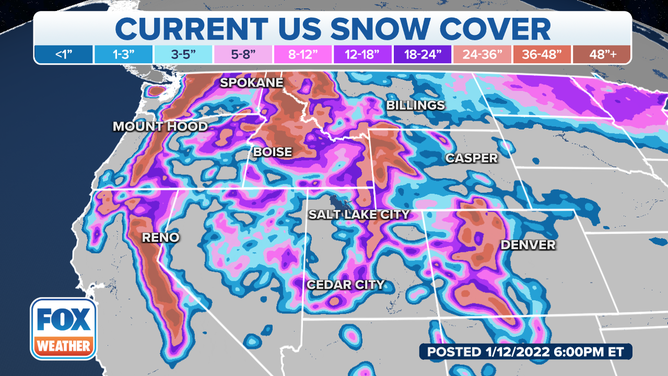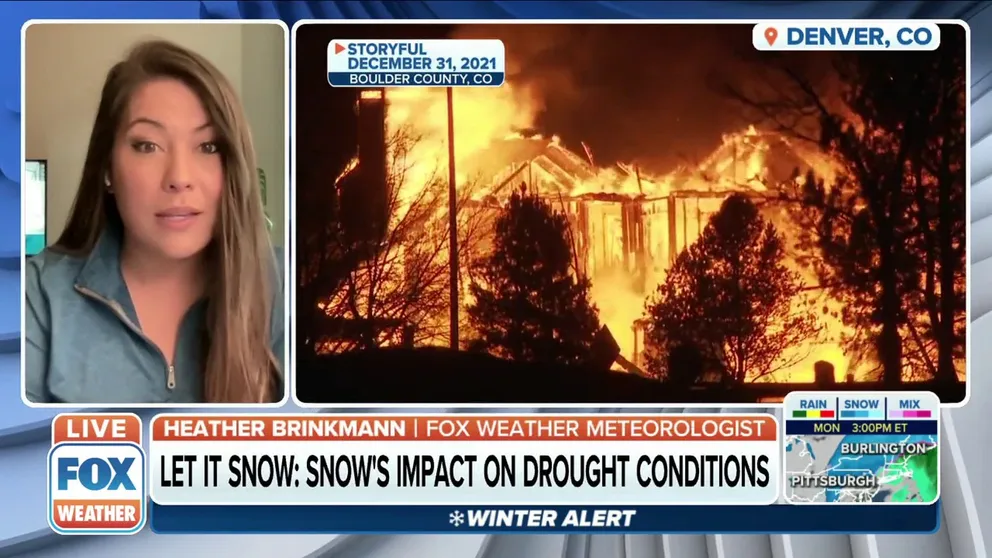Snowfall considered crucial for long-term drought mitigation
What is snow's impact on drought conditions?
FOX Weather Meteorologist Heather Brinkmann talks about how snowfall is crucial for long-term drought mitigation.
Drought was a contributing factor to multiple billion-dollar weather and climate disasters in the United States during 2021.
The National Oceanic and Atmospheric Administration even listed the Western drought as its own disaster causing nearly $9 billion in damage.
Dry, hot and windy weather combined with the vegetation can increase the probability of large-scale disasters, the National Integrated Drought Information System (NIDIS) says.
When there is a lack of precipitation, the combination of drought and fires continuously rank as some of the costliest disasters the U.S. sees each year.
Snow to the rescue

YOSEMITE NATIONAL PARK, CA - DECEMBER 16: Half Dome and the banks of the Merced River are coated in white after a major Pacific storm dumps a foot of in snow in Yosemite Valley (4,000 feet above sea leval) and 8-10 feet of powder in the higher elevations of the Park and along the Sierra Nevada crest on December 16, 2021, in Yosemite National Park, California. Even though it's still technically autumn, the transition to a more winter-like pattern of rain and snow has placed a hold on California's exceptional and extreme drought.
(George Rose/Getty Images / Getty Images)
A way to help mitigate drought conditions is through precipitation, especially snow.
According to the NIDIS, December storms brought more than 200% of average precipitation to a large area of California and Nevada, improving drought conditions. But precipitation in January and February is critical in determining whether the December storms were a drought buster, false hope, or somewhere between.
Warmer winter storms can lead to rain instead of snow at higher elevations in mountain regions, so the need for snow is crucial in order to avoid challenges in later months.
Snowpack is a natural reservoir, and an increased snow in the winter provides water throughout those drier summer months. The NIDIS says that a lack of snowpack storage, or shift in the timing of its melting season, can be challenging for drought planning.
And those that do the drought planning say that the La Niña pattern won't help a thick snowpack.
"The current circulation pattern (which is compounded by the western U.S. warming trend over the last 40 years) is causing precipitation to fall more often as rain than snow. This does not bode well for the winter mountain snowpack, which is crucial during the spring and summer melt season as a water supply during the dry season," Meteorologist for NOAA's National Centers for Environmental Information Richard Heim says.
Rain on top of snowfall could lead to disastrous conditions.
"Most of the rain from atmospheric river events is going to run off since so much falls so quickly, not as much soaking into the ground as could if it fell lighter over a longer period," Heim says.
So, to effectively chip away at the drought in the Western U.S., Heim notes it's all about timing.
"Slow spring and summer melt of the snowpack lets the moisture more efficiently soak into the soil and keeps a steady inflow into the reservoirs," he explains.
So how does the western U.S. fare?

Current U.S. snow cover as of Jan. 12, 2022.
(FOX Weather)
The NIDIS says that recent research shows that this part of the country has emerged as a global snow drought "hotspot," where snow droughts became more prevalent, intensified, and lengthened in the second half of the period 1980 to 2018.
According to the U.S. Drought Monitor and NOAA, drought coverage remained fairly significant and steady throughout much of 2021, with a minimum extent of 43.4% occurring on May 25 and maximum coverage of 55.5% on December 7.
In Colorado, snowpack for the Rockies is crucial. The state has seen several big snowstorms in the past weeks, contributing 129% of the average.
Along with a steady snowpack, consistently cold temperatures and continuous snow will be critical to much of the West and its drought.
